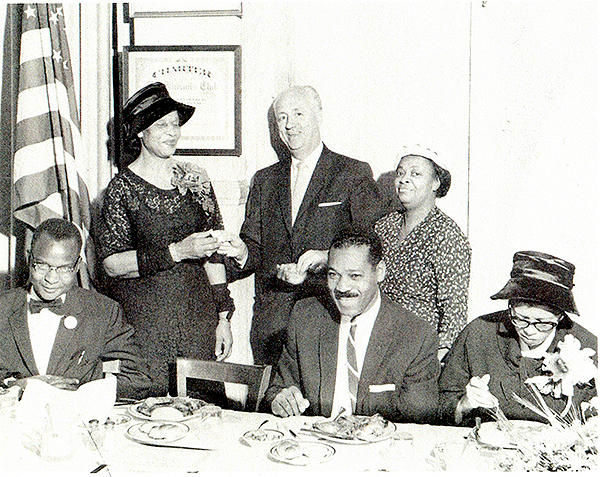Submitted by Al Shipley, City Historian and Rahway Library Research Consultant
During the summer of 1908, a violent two-day race riot broke out in Springfield, Illinois resulting in the death of seven people and the loss of over $200,000 in property damage. Editorial staffs of national newspapers and magazines, who for years had been reporting news regarding brutal hate crimes in the south, were appalled by the horrific event and covered the story in graphic detail. The Springfield tragedy, which occurred in the hometown of President Abraham Lincoln, would become the catalyst for the creation of the National Association for the Advancement of Colored People (NAACP).
Influential leaders, both white and African-American, who for decades after the Civil War had voiced angry protests against the continued plight of African-Americans, now demanded the creation of an effective civil rights organization. With this goal in mind, a meeting in New York was scheduled for February 12, 1909, a date that would coincide with the 100th anniversary of the birth of President Lincoln. Key figures at the inception of the new group included Mary White Ovington, a wealthy American suffragist and journalist, W.E.B. DuBois, an American Socialist, civil rights activist, author and editor, Moorfield Storey, an American lawyer and civil rights leader, and Ida B. Wells, a journalist and anti-lynching crusader. The official name for the group, National Association for the Advancement of Colored People, was chosen at its 2nd Conference on May 30, 1910. A year later, the NAACP was officially incorporated with the stated mission: “To promote equality of rights and to eradicate caste or race prejudice among the citizens of the United States; to advance the interest of colored citizens; to secure for them impartial suffrage; and to increase their opportunities for securing justice in the courts, education for the children, employment according to their ability and complete equality before law.”
Over the next few decades, the Association grew and local chapters were soon forming across the country. In Rahway, an NAACP charter was granted on August 13, 1934 at a meeting held at the Second Baptist Church. Leading members attending the presentation included Rev. J.W.P. Collier, Dr. Arthur Chapman, Mr. and Mrs. William P. Hammond, and Mr. and Mrs. Thomas Shell.
Early meetings of the Association were held at the Dunbar Community Center, a vacated city-owned fire house located on the corner of Milton Avenue and Augusta Street. The building, built in the 1850s, had been abandoned by the fire department in 1930 when it was deemed obsolete and in need of too many costly repairs. In 1936, city officials gave the group permission to utilize the building as a meeting hall and community center for minority groups. Four years later, however, use of the Community Center was lost when the city decided to modernize the old structure and reuse it as a fire station. Since the closing of the Dunbar Center, the group has been without a permanent home but has continued to meet in churches and meeting rooms.
Attentive to the mission of the national group, members of the Rahway Chapter have a long history of promoting equality of rights, fighting for fairness and equality in the workplace, fostering educational opportunities for children, and advancing the interests of African-Americans in the Rahway community.
The first years of the Rahway Chapter were spent on supporting antilynching protests that were being held in places throughout the United States. At the onset of World War II, with the creation of the Fair Employment Practices Commission, the local chapter monitored federal agencies, and all unions and companies engaged in war-related work to ensure their hiring practices were non-discriminatory. During the war years, the branch also furnished kits and materials to the segregated African- American soldiers at nearby Camp Kilmer (a military facility located two miles south of New Brunswick).
In the late ‘40s and into the 1950s, the Branch was instrumental in the integration of the Rahway Theater and the YMCA. They joined other cities in protesting the hiring and serving practices at White Castle Restaurants and F. W. Woolworth stores. In 1958 and 1959, the young members of the Branch joined the “Youth March for Integrated Schools” in Washington, D. C. staged to support the elimination of school segregation from American Public Schools. On August 28, 1963, members of the Branch again went to D. C. to be part of the 250,000 person “March on Washington for Jobs and Freedom” and were there to hear Martin Luther King Jr. give his famous “I Have a Dream” speech.
In a challenge to the Rahway School System, the Branch fought for the transfer of 5th and 6th graders from Grover Cleveland and Columbian Elementary Schools to Madison and Roosevelt as a step in reducing racial imbalance in the grammar schools. They also pushed for a course in Black Studies to be added to the curriculum, and advocated that the contributions made by African-Americans be taught in the classroom.
The Branch has also been a “watchdog” over several city projects. They were responsible for altering the flood remediation plans proposed by the Army Corps of Engineers in the mid-1960s that would have adversely affected predominately African-American neighborhoods. The plan that was ultimately approved has proven to be much safer for all residents in the surrounding area. In the 80s and 90s, they were active in monitoring the plans and construction of the Union County Resource Recovery Facility and fought to ensure that pollution safeguards conformed to the highest standards.
In recent years the focus of the Rahway Branch NAACP has been on strengthening the quality of African-American family life in the areas of housing, education, health, and employment. Entering their 83rd year, the Rahway Branch continues to be an active civic group adhering to the mission ideals set forth by the national organization over 100 years ago.

(above) Mrs. William Hammond (standing, left) welcomes Mayor Robert Henderson at a dinner/meeting of the Rahway–Carteret Chapter NAACP in the early 1960s.

